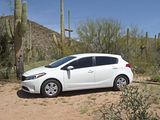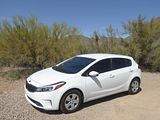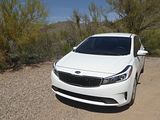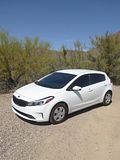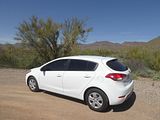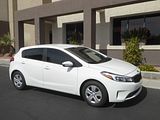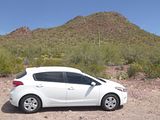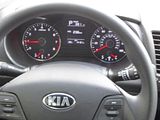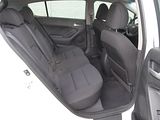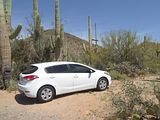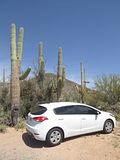As anyone who has even a reasonable amount of experience with the car rental world will know, there can be plenty of surprises awaiting the customer when it comes to the choice of car. Even before Hertz introduced their Ultimate Choice program, which allows customers to choose the specific car they want, against of set of rules governing which the sections of the facility from which you can make your selection, I had taken to wandering up and down the rows of cars, to see what was available. And so, with two or three trips to America a year, and an average of 25 – 30 rentals during those visits, I’ve got a pretty good idea of what is on fleet at any given time. But occasionally you see something parked up that you’ve just never come across before. This test car was one of those. I had just returned a Chevrolet Cruze Hatch at the Phoenix Sky Harbor location and meandered over to the rows of cars to go and select the next one, and almost the first car I spotted in the line was something I did not instantly recognise from the partial view I had of it. It turned out to be a Kia Forte5, the name that Kia gives to the hatchback version of their mid-sized model. The saloon versions of these are reasonably common in the fleet, and Hertz clearly bought quite a number of them just before the transition to the brand new 2019 model, but I’d never seen a Forte5 on offer before. This was a night (again) where choice at Phoenix was very limited, to it was not hard to decide to take this car and see what I thought of it. Having driven not just the Cruze hatch the day before, but also a Focus Hatch and a Golf within recent days, it would be the perfect opportunity to make direct comparisons with another class entrant.
Quite where it had come from, I really don’t know. The car had Florida plates, but I have noticed that quite a few of the rarer rental offerings at Phoenix have these, and yet the Hertz vehicle number has the code suggesting that Phoenix is actually the owning location. Looking in the glovebox, I found paperwork to suggest that the car had previously been plated in New Mexico, and that the original owner was not the usual Hertz name that you see on the registration document. The key tag said that it was a 2017 model, and indeed the plate in the door jamb confirmed that the car was built in October 2016, but this car had only covered 14,000 miles, a figure which most rental cars achieve in less than 6 months, so quite what its history was, remains a mystery.
The Forte is Kia’s competitor in what we would think of as the C-Segment, and the Americans call the mid-size. In its home Korean market, it is known as the K3, and in Europe it is not known at all, as the similarly sized Cee’d model is sold instead. The two cars don’t share very much, and they certainly look different although familiar Kia styling cues, such as the distinctive grille are present on both. This is the second generation of the Forte, and it was premiered in the summer of 2012, going on sale in the US as a 2014 model year car, with new swoopier styling making it look quite different to the rather boxier first generation model. Just as with the first generation car, there were three different bodystyles offered: 4 door saloon, 5 door hatch and a 2 door coupe. This Forte does not stray from the class norm in any respect, and was conceived to try to grab sales from the commercially more successful Toyota Corolla, Nissan Sentra and Honda Civic. Reviews at the time of its launch thought that Kia had done well, and the car won initial comparison tests. I had my first experience of a second generation Forte in September 2016, and found much to like, although this was not a particularly characterful car. I certainly thought it better than the three Japanese rivals just mentioned, but wondered how it would fare against more recent rivals that at the time I had not sampled, such as its closely related Hyundai Elantra cousin, the Cruze and the Mazda 3. Kia did make some changes to the Forte for the 2017 model, with a new front end design being the most obvious recognition point. But since that time, many of its rivals have been updated with new models, something which Kia themselves have done for 2019, with a third generation car.
As part of the upgrade for 2017 model year cars, Kia replaced the 1.8 litre engine with a 2 litre unit, which puts out just 2 bhp more than the old unit at 147 bhp, still slightly below the class average. It has not been seen by the American press as much of an improvement, and they still think that the engine and the performance it delivers is the weakest feature of the car. I was not so critical. For a start, there was quite an appealing almost throaty roar to it when under load, which I rather liked. And the Forte seemed willing enough. For sure, it is not all that fast, but then nor are any of its rivals, and there are more potent power units available if you really do think that you need more. But with this unit and the six speed automatic gearbox, which did a good job at finding the right ratio for the occasion, the Forte5 will prove brisk enough, with ample acceleration available when called for. At a steady speed, noise levels are pleasingly low, with not much intrusion from engine, tyres or the wind. I took the Forte5 down to Tucson and back, as well as up into the hills above Phoenix, so covered 366 miles during the day, and it consumed 9.5 gallons, giving a consumption of 38.5 mpg US or 46.0 mpg Imperial, an impressive result and a bit better than I achieved with the Focus and the Cruze.
There are no real surprises concerning the other driving dynamics. This is not quite at the Focus, Mazda 3 or Golf level, but it is not too far behind, and there is nothing to cause concern or undue complaint. The steering is light, but has still got some feel. The handling is predictable, with plenty of grip, and a slight tendency to understeer, but only if you really tackle the bends with enthusiasm, and boy roll is well controlled. Perhaps more importantly, the ride was good on all surfaces. The Forte5 came on smaller than average 195/65 R15 wheels, with a plastic wheel trim, but unlike the Cruze, which had one inch bigger tyres, did not look under-wheeled. I had no issues with the brakes. A conventional pull-up handbrake is fitted between the seats. Visibility is good, too, with the back of the car easy enough to judge even without the assistance of the rear-view camera that I was rather expecting to see, but did not. There is a good field of view from the door mirrors. The compact dimensions of the Forte5 make it easy to position, manoeuvre and to park up.
The interior of this Forte5 looked to be identical to the one in the 2016 test car. When the second generation Forte was first launched, it was the quality here which gained immediate praise, with far greater use of soft touch materials than were evident in any of its rivals. Whilst it is still true that it is made out of nicer materials than you will find in most competitors – the Golf being the notable exception, head and shoulders above everything else – it does look a bit outmoded now, with a very small audio unit display screen and graphics that are definitely not contemporary any more. But everything here is neat and easy to use, if a bit sombre with all the black colouring lightened only by careful use of chrome highlighter rings. The instrument cluster contains two large dials for speedo and rev counter and two smaller ones for fuel level and water temperature. There are two column stalks for indicators and lights on the left and wipers on the right, repeater audio buttons and the cruise control on the spokes of the plastic moulded steering wheel and then in the centre of the dash that slightly old-tech screen that delivers audio services and not much else, lacking even the back-up camera (a clear clue to this being a 2017 model car, as all 2018 cars had to have them in the US) and certainly without navigation in this entry level car. You do at least get Satellite XM radio, though the subscription had expired on the test car. There is air conditioning rather than automated climate control, operated with three rotary dials and you start the Forte5 with a conventional key in the ignition slot. You need to remember to turn the lights on yourself, too, as there is no auto function for these. It is all very neat and easy to use, but a bit “last generation” now.
Seat adjustment is manual, as you would expect in this class of car. There’s a lever under the cushion for fore and aft and two separate ones on the side for backrest rake and seat height. For that driver that is, the front passenger seat is not height adjustable. I was pleased to see that the seat belt height was adjustable, as in the last two cars it had not been and was set lower than I would like. The steering column telescopes in/out as well as up/down, and so it was easy to get the driving position I wanted.
There is a decent amount of space in the rear seats. Legroom is adequate even if the front seats are set well back, and headroom should not be a problem. After needing to remember to duck my head to get in and out of the Cruze, it was good to find that there were no such issues here. A drop down armrest, with cupholders in the upper surface features and as well as the bins on the doors there is one map pocket, on the back of the front passenger seat for bits and pieces. Inside the cabin, there is a good-sized glovebox, pockets on all the doors and a small cubby under the central armrest, as well as an open area in front of the gearlever.
When I opened the boot for the first time, I noticed that there was a clear plastic protector across the top of the rear bumper, which seemed like a good idea, as almost every rental car in the US bears scuffs here as people drag their bags in and out. It had a Kia logo on it, so is an official thing not a Hertz addition. The boot on the Forte5 is a good size, similar to that you will find in the Cruze Hatch or the Focus and there was a parcel shelf to protect the contents from undesired attention. A spare wheel well under the boot floor has some space around it for odds and ends. More luggage capacity can be created by dropping the asymmetrically split rear seat backrests down, to create a longer and flat load bay.
Withe production of the two door Koup model having ended in 2016, that reduced the choice to two models: the sedan, which is just called the Forte, and the hatchback, which is known as the Forte5. Each comes in three trims, and two of the trims are the same in each body style. Entry point to the range is the Forte LX, which has a base price of $16,800. It comes standard with the 147 bhp four-cylinder engine, a six-speed manual transmission, Bluetooth, a tilt-and-telescoping steering wheel, a four-speaker stereo, satellite radio, and a USB port. About the only upgrade the LX offers is a six-speed automatic transmission, which you can add for $1,100. The Forte5 LX has a starting price of $18,300 and this also comes with the 164 bhp four-cylinder engine, a six-speed automatic transmission, and power-folding outside mirrors. It’s available with the LX Popular Plus package ($2,000), which includes a rearview camera and the UVO infotainment system with a 7-inch touch screen, Apple CarPlay, and Android Auto. The Forte S starts at $19,400. The S trim is only offered as a sedan. In addition to the LX sedan’s features, the S comes with a six-speed automatic transmission, 16″ alloys. a rearview camera, and the UVO infotainment system with a 7-inch touch screen, Apple CarPlay, and Android Auto. The Forte S offers the S Technology Plus package ($1,700), which adds a sunroof and several driver assistance features, such as blind spot monitoring, lane departure warning, forward collision warning, and more. The Forte EX has a starting price of $21,700. The EX sedan comes with a 164 bhp four-cylinder engine, 16″ alloys, leather upholstery, heated front seats, dual-zone automatic climate control, blind spot monitoring, lane change assist, and a rear cross traffic alert. The EX Premium Plus package ($3,900) adds a power-adjustable driver’s seat, ventilated front seats, navigation, HD Radio, a sunroof, and several driver assistance features. The Forte5 EX starts at $22,200. It comes with the Forte5 LX’s features plus leather upholstery, heated front seats, a rearview camera, and the UVO infotainment system with a 7-inch touch screen, Apple CarPlay, and Android Auto. The EX Premium Technology package ($3,600) adds a power-adjustable driver’s seat, ventilated front seats, navigation, HD Radio, a sunroof, dual-zone automatic climate control, and several driver assistance features. Top of the range is the Kia Forte5 SX, which has a starting price of $23,900. It comes standard with a 201 bhp turbo-four engine and a seven-speed dual-clutch automatic transmission. You can get a six-speed manual transmission for $2,200. Other than the powertrain, the SX’s standard and available features are the same as the Forte5 EX’s. The only difference is that in this trim, the option package is known as the SX Premium Technology package. The price is the same.
I rather liked this Forte5. In LX trim it is certainly not a luxury car, but then look at the price, and it would be unfair to expect it to be so. To my eyes, it looks good, better probably than the saloon version, and there were no significant weaknesses evident from a day’s testing. Only the slightly old-school interior fittings count against it. Objectively, it is not as good as the Golf – but then that will cost you a lot more money, and the American media are not sanguine about its reliability prospects – or even the Focus, though you would have to live with that rather low-rent interior. That leaves the Mazda 3, a car that I rated very highly when I drove it. Like the Forte, a new one is just going on the road, and unlike the Forte, it will continue to be available as a Hatch as well as Saloon. It will be interesting to try both these new offerings out on a future trip. Unless you have the same sort of surprise as I did, you are unlikely to find another Forte5 in the rental car aisles, but if you find the very similar Saloon model, it is not a car to walk away from, and if you do find the Forte5, well, you get something that has all the same strengths, hatch versatility and, arguably, better looks.


